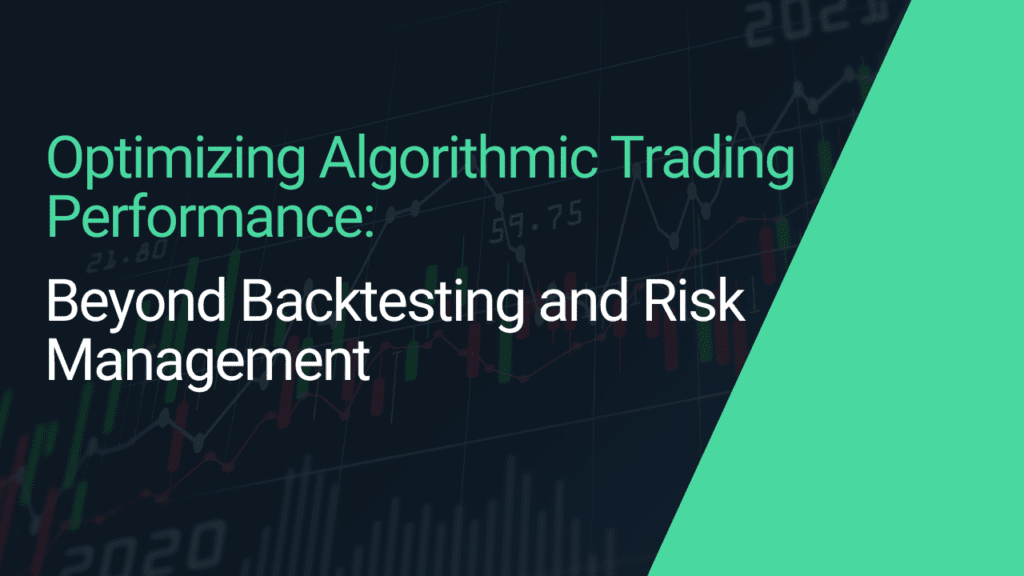Optimizing Algorithmic Trading Performance: Beyond Backtesting and Risk Management

Algorithmic trading, or algo trading, involves using computer programs to execute trades based on predefined criteria. While the potential for profits can be significant, it’s crucial to manage risks effectively and validate strategies through back testing.
The Many Faces of Risk in Algo Trading :
Think of risk as the thorns in the financial jungle. They’re unavoidable, but with the right approach, you can minimize their impact. Here’s a breakdown of the key risks to be aware of:
- Market Risk: This is the inherent volatility of the markets. Even the best algorithm can’t predict the future perfectly, and sudden price swings can throw your strategy off balance.
- System Risk: Technical glitches, software bugs, and data errors can cripple your algorithm’s performance. Imagine your hunter tripping over a hidden root – a system failure can have a similar effect.
- Execution Risk: This covers the gap between your desired trade and the actual execution. Factors like slippage (when the executed price differs from the desired price) can eat into your profits.
- Overfitting Risk: This happens when your algorithm becomes too focused on historical data, leading to poor performance in new market conditions. It’s like your hunter getting fixated on a single type of prey and failing to adapt when the environment changes.
- Behavioral Risk: Even in the realm of algorithms, emotions can creep in. Overconfidence or fear of missing out can cloud your judgment and lead to rash decisions about your strategy.
The Power of Backtesting : A Look Back to Move Forward
Backtesting is your training ground before venturing into the real market. It involves simulating your trading strategy on historical data to see how it would have performed. Think of it as building a virtual jungle gym for your hunter to practice their skills. Backtesting helps you :
- Identify Strengths and Weaknesses: By analyzing the simulated results, you can see how your algorithm reacts under different market conditions. Were there periods of significant losses? Did it capture profitable opportunities effectively?
- Quantify Risks: Backtesting allows you to measure metrics like maximum drawdown (the largest peak-to-trough decline) and Sharpe Ratio (a measure of risk-adjusted return). These metrics provide a clearer picture of potential risks associated with the strategy.
- Optimize and Refine: Backtesting lets you experiment with different parameters within your algorithm. You can adjust entry and exit signals, position sizing, and risk management rules to improve the strategy’s performance.
Building a Robust Risk Management Framework :
Now that you understand the risks and the power of backtesting, let’s explore specific tactics to manage risk in your algo trading endeavors :
- Position Sizing: This dictates how much capital you allocate to each trade. A common approach is the fixed fractional method, where you risk a fixed percentage (e.g., 1%) of your capital per trade. This helps spread your risk and prevents a single bad trade from wiping out your account.
- Stop-Loss Orders: These are automated orders that automatically exit a trade once the price reaches a certain level, limiting potential losses. Think of them as safety nets for your hunter, preventing them from getting stuck in a losing position.
- Take-Profit Orders: Similar to stop-loss orders, but on the other side of the coin, these orders automatically lock in profits when the price reaches a desired level. They ensure you don’t miss out on profitable opportunities and prevent greed from clouding your judgment.
- Order Types: Different order types can help you manage risk in specific situations. Trailing stop-loss orders, for example, automatically adjust the stop-loss price as the price moves in your favor, locking in profits while allowing for some volatility.
Beyond the Backtest: Continuous Monitoring and Improvement :
Backtesting is a crucial first step, but the market is a living beast. What worked in the past might not work today. Here’s how to stay ahead of the curve :
- Monitor Performance: Regularly monitor your live trading results and compare them to your backtested performance. Analyze any discrepancies and adjust the algorithm accordingly.
- Market Updates: Stay informed about upcoming economic events and potential market shifts. This allows you to refine your strategy or temporarily pause trading if necessary.
- Stress Testing Revisited: Periodically stress test your algorithm under extreme market conditions